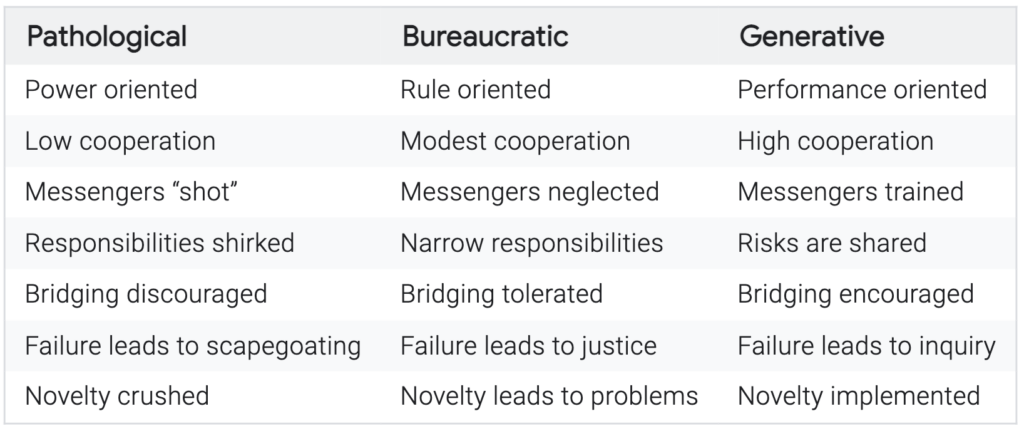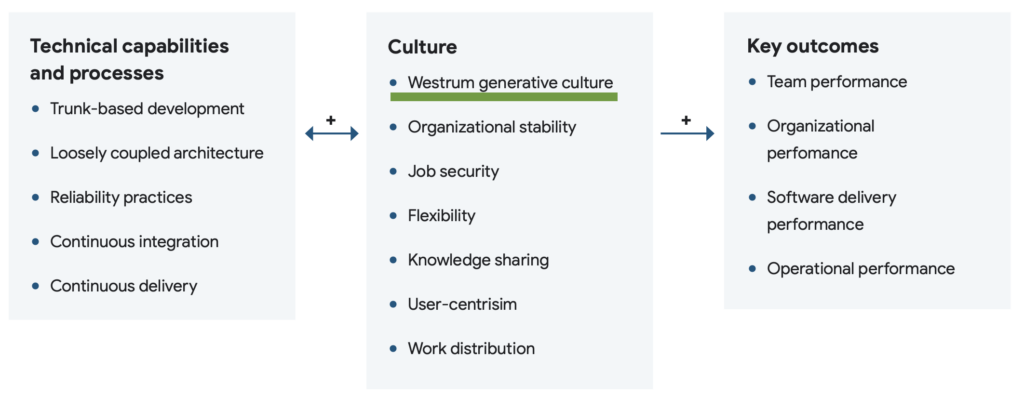
Embracing generative culture: the foundation to building high performing teams
In my first post of the series about building high performing teams, I shared the single biggest factor in developer performance: skills!
In this second post, I’ll focus on a pivotal aspect that can make or break the journey: organizational culture, specifically the generative culture. Based on my experience and the insights offered by the DevOps Research and Assessment (DORA), I will share a few concrete steps you can undertake to cultivate a generative culture, a critical enabler of the 10x factor in engineering performance.
What the hell is a generative culture?
Dr. Ron Westrum, a sociologist, researched and identified a correlation between a robust culture, which facilitates the flow of information, and positive business outcomes.
From his research, he formulated a typology to describe various organizational cultures.
 Credits: dora.dev
Credits: dora.dev
Building a generative culture is one of the 27 DORA capabilities, with demonstrated leverage in increasing team performance. As you can see in the chart below, generative culture and process capabilities required to improve delivery performance build on and reinforce each other.
 Credits: dora.dev
Credits: dora.dev
And that makes sense. Have you seen many examples of teams deploying multiple times a day in a culture that is bureaucratic and where failure leads to punishment? Another way to think about Westrum’s findings is to consider code as text — information that flows through the dev lifecycle to ultimately be transformed into an experience for the end user. Back to the initial statement: there is a correlation between a robust culture that facilitates the flow of information and positive business outcomes.
Leading by example
So the generative culture promotes an environment where information flows freely, and innovative ideas are nurtured, creating a fertile ground for high performance and continuous improvement. Cool, but how to get there?
First, let me get back to a moment that was eye-opening for me. During a 360-review, one piece of feedback really caught my attention: ‘Sometimes Laurent will elaborate and make up an answer even if it is clear that he doesn’t know the answer.’ For a long time, I always wanted to appear right and avoid showing any vulnerability to the extent that I wasn’t able to say, ‘I don’t know or I failed.’ The message this sent to the team was terrible: it is not acceptable to lack answers or to fail. That was an aha moment for me that completely transformed my approach.
Yes, as leaders, we should often be right, as per one of Amazon’s leadership principles. However, it is okay to be wrong sometimes. Being humble, open to being wrong is an opportunity to learn and improve. It also shows your team that you are authentic and vulnerable. This is how you create the psychological safety necessary for a team to thrive, give their best, and sometimes fail.
Same goes with failure. Failure should lead to inquiry instead of scapegoating. There is no innovation without failure. Failures that lead to learning have compounding effects. Without learning, this is just a waste. And this is really aligned with the lean principle of seeking constant improvement. Interestingly I have seen engineering teams way more comfortable with the approach to failure than their leadership.
Concrete steps to create a generative culture
Here are some concrete steps you can take to create a generative culture:
- Demonstrate Leadership Commitment and Role Modeling: Leadership must visibly commit to and model the behaviors that encourage a generative culture. This includes showing vulnerability, admitting mistakes, and fostering an environment where learning from failures is valued over assigning blame.
- Encourage and Reward Collaboration:Implement systems that reward teamwork and collaboration over individual accomplishments. This can include revising performance metrics to reflect team achievements and promoting cross-functional projects. Many teams have found success using Objectives and Key Results (OKRs), among other goal-setting frameworks. The key point is to measure success at the team level, reinforcing the concept that the team is the primary unit of progress.
- Promote Psychological Safety: Actively foster an environment where all team members feel safe to express their ideas, concerns, and questions without fear of retribution. Encourage open debates and constructive conflict to create healthy cognitive friction. It’s crucial for teams to engage in explicit debates, disagree openly, and commit to decisions once everyone has been heard, rather than silently disagreeing and potentially undermining the decisions made.
- Implement Blameless Postmortems: Focus on learning, not blame, when issues arise. Blameless postmortems are critical for uncovering root causes without finger-pointing, thereby nurturing a culture of learning and continuous improvement. This approach is a key marker of a generative culture. Toyota’s adoption of the Dantotsu Radical Quality Improvement method, transforming it into a symbol of quality excellence, exemplifies this principle at its best. This approach to quality has been successfully implemented by the tech industry as well.
- Strive for Information Transparency and Clarity: Promote open access to information necessary for decision-making at all levels. The more information teams have about the strategy, finances, and goals of the organization, the better their decisions will be. Of course, this means that these elements must be clearly defined and without ambiguities. This context becomes the enabling constraints for the teams, guiding them within a framework that empowers autonomy while aligning with the organization’s overall objectives.
- Celebrate Innovation, experimentation: Create programs that reward innovation and experimentation, even when they don’t always lead to success. Recognizing and celebrating attempts at innovation encourages a culture of continuous improvement and risk-taking. Leverage hackathons to create opportunities for cross-functional learning, aiming to explore new territories.
- Foster Continuous Learning: As discussed in my first post, learning and upskilling are the biggest levers for improving engineering performance. Invest in your team’s continuous development by providing access to training and education, supporting participation in industry conferences and workshops, and emphasizing learning by doing—the biggest missed opportunity. The most successful organizations implement mentoring programs, pair or mob programming, Brown Bag Lunches (BBL), and internal conferences to promote a culture of knowledge sharing and learning by doing. Retention rates are significantly higher. These principles underpin Packmind, the platform enabling developers to share, learn, and refine their craft daily while enhancing their workflow.
This is obviously not an overnight transformation and it starts from the CEO and ELT. It always struck me how much influence the CEO has on the culture compared to the relative influence on the execution. And that’s okay, because culture is a significant lever on people’s behavior and organizational outcomes. By fostering an environment of psychological safety, collaboration, and continuous learning, organizations can unlock the 10x factor, driving unparalleled performance and innovation.
I am eager to learn more about your experiences. How have you fostered a Generative culture within your organization? What challenges and successes have you encountered in this journey?
Leave a comment